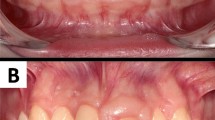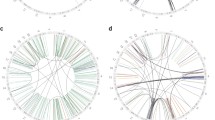Abstract
Hereditary hyperplastic gingivitis (HHG) is an autosomal recessive disease that presents with progressive gingival proliferation in farmed silver foxes. Hereditary gingival fibromatosis (HGF) is an analogous condition in humans that is genetically heterogeneous with several known autosomal dominant loci. For one locus the causative mutation is in the Son of sevenless homologue 1 (SOS1) gene. For the remaining loci, the molecular mechanisms are unknown but Ras pathway involvement is suspected. Here we compare sequences for the SOS1 gene, and two adjacent genes in the Ras pathway, growth receptor bound protein 2 (GRB2) and epidermal growth factor receptor (EGFR), between HHG-affected and unaffected foxes. We conclude that the known HGF causative mutation does not cause HHG in foxes, nor do the coding regions or intron–exon boundaries of these three genes contain any candidate mutations for fox gum disease. Patterns of molecular evolution among foxes and other mammals reflect high conservation and strong functional constraints for SOS1 and GRB2 but reveal a lineage-specific pattern of variability in EGFR consistent with mutational rate differences, relaxed functional constraints, and possibly positive selection.

Similar content being viewed by others
References
Aguirre-Hernandez J, Sargan DR (2005) Evaluation of candidate genes in the absence of positional information: a poor bet on a blind dog! J Hered 96:475–484
Auton A, Li YR, Kidd J, Oliveira K, Nadel J, Holloway JK, Hayward JJ, Cohen PE, Greally JM, Wang J, Bustamante CD, Boyko AR (2013) Genetic recombination is targeted towards gene promoter regions in dogs. PLoS Genet 9:e1003984
Cheng AM, Saxton TM, Sakai R, Kulkarni S, Mbamalu G, Vogel W, Tortorice CG, Cardiff RD, Cross JC, Muller WJ, Pawson T (1998) Mammalian Grb2 regulates multiple steps in embryonic development and malignant transformation. Cell 95:793–803
Clark JBJ, Hudson RC, Marshall HD (2014) Index case report of hereditary hyperplastic gingivitis in North American farmed silver fox, Vulpes vulpes. Can Vet J (in press)
Comeron JM, Aguade M (1998) An evaluation of measures of synonymous codon usage bias. J Mol Evol 47:268–274
Dharmawardana PG, Peruzzi B, Giubellino A, Burke TR Jr, Bottaro DP (2006) Molecular targeting of growth factor receptor-bound 2 (Grb2) as an anti-cancer strategy. Anticancer Drugs 17:13–20
Dyrendahl S, Henricson B (1960) Hereditary hyperplastic gingivitis of silver foxes. Acta Vet Scand 1:121–139
Findlay GM, Pawson T (2008) How is SOS activated? Let us count the ways. Nat Struct Mol Biol 15:538–540
Goldblatt J, Singer SL (1992) Autosomal recessive gingival fibromatosis with distinctive facies. Clin Genet 42:306–308
Hart TC, Zhang Y, Gorry MC, Hart PS, Cooper M, Marazita ML, Marks JM, Cortelli JR, Pallos D (2002) A mutation in the SOS1 gene causes hereditary gingival fibromatosis type 1. Am J Hum Genet 70:943–954
Ishii S, Xu YH, Stratton RH, Roe BA, Merlino GT, Pastan I (1985) Characterization and sequence of the promoter region of the human epidermal growth factor receptor gene. Proc Natl Acad Sci USA 82:4920–4924
Kraskouskaya D, Duodu E, Arpin CC, Gunning PT (2013) Progress towards the development of SH2 domain inhibitors. Chem Soc Rev 42:3337–3370
Liu W, Innocenti F, Wu MH, Desai AA, Dolan ME, Cook EH Jr, Ratain MJ (2005) A functional common polymorphism in a Sp1 recognition site of the epidermal growth factor receptor gene promoter. Cancer Res 65:46–53
Lurje G, Lenz HJ (2009) EGFR signaling and drug discovery. Oncology 77:400–410
MacDonald JH, Kreitman M (1991) Adaptive protein evolution at the Adh locus in Drosophila. Nature 351:652–654
Mangino M, Pizzuti A, Dallapiccola B, Bonfante A, Saccilotto D, Cucchiara E (2003) Hereditary gingival fibromatosis (HGF) with hypertrichosis is unlinked to the HGF1 and HGF2 loci. Am J Med Genet A 116A:312–314
Murphy WJ, Eizirik E, Johnson WE, Zhang YP, Ryder OA, O’Brien SJ (2001) Molecular phylogenetics and the origins of placental mammals. Nature 409:614–618
Pampel M, Maier S, Kreczy A, Weirich-Schwaiger H, Utermann G, Janecke AR (2010) Refinement of the GINGF3 locus for hereditary gingival fibromatosis. Eur J Pediatr 169:327–332
Pierre S, Bats AS, Coumoul X (2011) Understanding SOS (Son of Sevenless). Biochem Pharmacol 82:1049–1056
Qian X, Esteban L, Vass WC, Upadhyaya C, Papageorge AG, Yienger K, Ward JM, Lowy DR, Santos E (2000) The Sos1 and Sos2 Ras-specific exchange factors: differences in placental expression and signaling properties. EMBO J 19:642–654
Ramer M, Marrone J, Stahl B, Burakoff R (1996) Hereditary gingival fibromatosis: identification, treatment, control. J Am Dent Assoc 127:493–495
Rozen S, Skaletsky H (2000) Primer3 on the WWW for general users and for biologist programmers. Methods Mol Biol 132:365–386
Scaltriti M, Baselga J (2006) The epidermal growth factor receptor pathway: a model for targeted therapy. Clin Cancer Res 12:5268–5272
Schulze C, Bensch M, Winterhoff N, Ansorge H, Teifke JP (2008) Gingival fibromatosis (hereditary hyperplastic gingivitis) in a wild European red fox (Vulpes vulpes). Dtsch Tierarztl Wochenschr 115:471–474
Shashi V, Pallos D, Pettenati MJ, Cortelli JR, Fryns JP, von Kap-Herr C, Hart TC (1999) Genetic heterogeneity of gingival fibromatosis on chromosome 2p. J Med Genet 36:683–686
Tamura K, Peterson D, Peterson N, Stecher G, Nei M, Kumar S (2011) MEGA5: molecular evolutionary genetics analysis using maximum likelihood, evolutionary distance, and maximum parsimony methods. Mol Biol Evol 28:2731–2739
Xiao S, Bu L, Zhu L, Zheng G, Yang M, Qian M, Hu L, Liu J, Zhao G, Kong X (2001) A new locus for hereditary gingival fibromatosis (GINGF2) maps to 5q13-q22. Genomics 74:180–185
Yang Z (2007) PAML 4: phylogenetic analysis by maximum likelihood. Mol Biol Evol 24:1586–1591
Ye X, Shi L, Cheng Y, Peng Q, Huang S, Liu J, Huang M, Peng B, Bian Z (2005) A novel locus for autosomal dominant hereditary gingival fibromatosis, GINGF3, maps to chromosome 2p22.3-p23.3. Clin Genet 68:239–244
Acknowledgments
We gratefully acknowledge Dr. Robert Hudson, from Animal Health Division, Department of Natural Resources, Government of Newfoundland and Labrador, for his time and dedication with caring for the animals and sample collection. We would also like to thank Dr. Laura Rogers, Animal Health Division, Department of Natural Resources, Government of Newfoundland and Labrador, for aiding with sample collection. Finally, we would like to acknowledge Merv Wiseman for bringing this issue to our attention and providing us samples of affected fox and for the many opportunities he gave us to observe and examine foxes on the farm as well as review his breeding records.
Author information
Authors and Affiliations
Corresponding author
Rights and permissions
About this article
Cite this article
Clark, JA.B.J., Tully, S.J. & Dawn Marshall, H. Sequence analysis of the Ras-MAPK pathway genes SOS1, EGFR & GRB2 in silver foxes (Vulpes vulpes): candidate genes for hereditary hyperplastic gingivitis. Genetica 142, 517–523 (2014). https://doi.org/10.1007/s10709-014-9798-x
Received:
Accepted:
Published:
Issue Date:
DOI: https://doi.org/10.1007/s10709-014-9798-x




